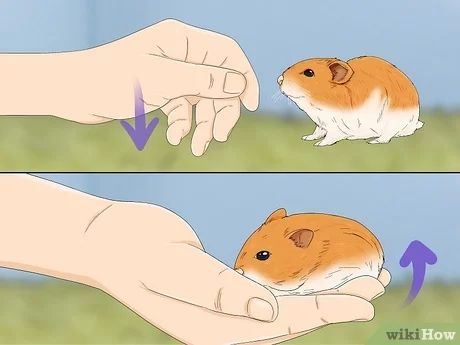Key Takeaways
-
Understanding your rescue hamster’s personality is the first step to effective training.
-
Training should be done in a calm, designated space with minimal distractions.
-
Consistency and patience are crucial; set a daily routine for your hamster’s training.
-
Keep training sessions short to maintain your hamster’s attention.
-
Clicker training is a highly effective method to teach your hamster new behaviors.
Hamster Training Basics: Unlocking Your Pet’s Potential
Welcoming a rescue hamster into your home is not just about providing a safe haven; it’s about creating a bond that enriches both your lives. Training your furry friend is a fantastic way to build this connection. It’s not just about tricks and commands; it’s about understanding and communication. It’s about learning the language of mutual respect and love.

“How to Train Your Hamster: Basic …” from www.wikihow.com and used with no modifications.
Understanding Your Hamster’s Personality
Every hamster is an individual, with its own quirks and habits. Some may be shy and reserved, while others are curious and outgoing. Spend time observing your hamster to understand its personality. Does it eagerly approach when you come near, or does it tend to hide? This will guide you in how to approach training sessions in a way that’s comfortable for your hamster.
For example, a timid hamster might need a quieter approach and more time to warm up to you. On the other hand, an adventurous hamster might be ready to dive into training with less hesitation. Remember, rescue hamsters may have had past experiences that make them more cautious, so patience is key.
Essential Training Supplies Checklist
-
A quiet, safe space for training away from noise and household traffic
-
A small clicker device for clicker training
-
Treats that your hamster loves and is willing to work for
-
A comfortable, secure area for your hamster to rest between sessions
-
Training aids like tunnels or platforms, depending on the tricks you want to teach
Now that you’ve got the basics down and know what you’ll need, let’s get into the heart of training your rescue hamster.
Creating a Daily Routine for Your Rescue Hamster
Hamsters thrive on routine. It gives them a sense of security and helps them adjust to their new environment. Establishing a daily training schedule is not only about discipline; it’s about creating a rhythm that your hamster can anticipate and look forward to.
Benefits of a Consistent Schedule
By training at the same time each day, you’re giving your hamster a structure that can ease anxiety. This is especially important for rescue hamsters, who may have had unstable pasts. A routine helps them understand that they’re in a safe place where good things – like playtime with you – happen regularly.
How Routine Can Help Your Rescue Hamster Adjust & Adapt
Regular training sessions also help your hamster adapt to their new home. It’s a time for them to learn about you – your scent, your voice, and your mannerisms. As they grow more familiar with you through training, they’ll start to see you as a source of comfort and companionship.
Designing Your Hamster’s Training Routine
Choose a time of day when your hamster is most active, typically during the evening. Ensure the training area is quiet and free from distractions. Start with a simple routine that includes taking your hamster out of its cage, guiding it through a few basic exercises, and then giving it some free time to explore and play.
As your hamster gets used to the routine, you can gradually introduce more structured training exercises. Remember, the key is to move at your hamster’s pace and keep the experience positive.
Effective Training Session Duration
Hamsters have short attention spans, so it’s important to keep training sessions brief. Around 10-15 minutes is ideal. This ensures that your hamster stays engaged and doesn’t become overwhelmed or stressed.
Optimizing Session Length for Maximum Attention
Within those 10-15 minutes, focus on one or two behaviors or tricks. This allows your hamster to concentrate on learning specific tasks without getting confused.
Signs Your Hamster Needs a Break
If you notice your hamster getting distracted, nibbling at the bars of its playpen, or looking for ways to escape, it’s time to wrap up the session. Always end on a positive note with a treat or some gentle petting to ensure your hamster associates training with positive experiences.
Now that we’ve covered the basics and the importance of a routine, in the next section, we’ll delve into the specifics of clicker training and how to use positive reinforcement to effectively train your rescue hamster.
Clicker Training: A Step-by-Step Guide
Clicker training is a powerful tool in the world of pet training, and it’s great for hamsters too. This method uses a small device that makes a clicking sound to mark the exact moment your hamster does something right. It’s like taking a snapshot of the behavior you want to encourage.
Before diving into the tricks and commands, it’s important to create a positive association with the clicker. Start by simply clicking and immediately giving your hamster a treat. Do this a few times until your hamster starts to understand that the click means something good is coming. This is the foundation of clicker training.
Introducing the Clicker to Your Hamster
Begin by holding a treat in your hand and wait for your hamster to approach. The moment it takes a step towards you, click and give it the treat. Repeat this several times during your training session. Your goal here is to help your hamster make the connection between the click, the action, and the reward.
Keep these initial sessions short and sweet. If your hamster seems disinterested or scared, take a step back and give it some time. Remember, the idea is to make training a fun and rewarding experience.
Progressive Training Techniques with a Clicker
Once your hamster understands that the clicker is a positive signal, you can start using it to shape new behaviors. For example, if you want to teach your hamster to go through a tunnel, you would click and treat the moment it shows any interest in the tunnel. Gradually, you would only click when your hamster enters the tunnel, and then eventually when it goes all the way through.
This process of reinforcing successive steps towards the desired behavior is called ‘shaping’. It’s a gradual way to guide your hamster towards more complex actions.
Mastering Positive Reinforcement
Positive reinforcement is the cornerstone of effective training. It’s about rewarding your hamster for good behavior, which encourages them to repeat it. The reward can be a tasty treat, a gentle stroke, or even a soft word of praise. The key is to make sure the reward is something your hamster values. For more on keeping your hamster active and engaged, check out these hamster fitness tips.
The Art of Rewarding Your Hamster
To master positive reinforcement, pay close attention to timing. The reward should come immediately after the desired behavior, so your hamster knows exactly what it did right. If you wait too long, your hamster might not make the connection, and the training won’t be as effective.
Also, vary the rewards to keep things interesting for your hamster. If you always give the same treat, your hamster might get bored. Mixing up the types of treats and alternating with affection will keep your hamster guessing and eager to please. For more ideas on how to bond with your pet, check out these tips which can be adapted for your hamster too.
Avoiding Common Positive Reinforcement Mistakes
One common mistake in training is inconsistent reinforcement. If you only reward your hamster sometimes, it might get confused and less likely to repeat the behavior. Be consistent with your rewards to establish a clear pattern for your hamster to follow.
Another mistake is over-rewarding. If your hamster gets treats too often, it might become less motivated to earn them. Make sure to reward only for correct behaviors, and as your hamster learns, gradually reduce the frequency of treats so that the behavior becomes a habit.
Teaching Advanced Hamster Tricks
Once your hamster has mastered the basics, you can start teaching it more advanced tricks. This keeps training sessions exciting and challenging for your hamster, which is great for its mental stimulation and overall well-being.
Building up from Basic Commands
Start with simple commands like ‘come’ or ‘spin’. To teach ‘come’, place a treat in your hand and say the command. Use the clicker the moment your hamster moves towards you, and give it the treat when it reaches your hand. For ‘spin’, hold a treat above your hamster’s head and slowly move it in a circle. Click and treat as soon as your hamster completes the turn.
Remember, the key to success is patience and repetition. Don’t expect your hamster to learn these tricks overnight. It may take several sessions for it to catch on, but with consistency, it will get there.
Creative Trick Ideas to Try Out
Here are some fun tricks you can teach your hamster:
-
Stand – Hold a treat just above your hamster’s head and click when it stands on its hind legs to reach it.
-
Jump – Create a small hoop with your fingers and encourage your hamster to jump through it for a treat.
-
Fetch – Teach your hamster to fetch a small ball or toy and bring it back to you for a reward.
Keeping Your Hamster Engaged with Variety
Hamsters can get bored with repetition, so it’s important to keep training sessions varied and fun. Introduce new tricks and challenges regularly, and don’t be afraid to get creative. Training should be a joyful time for both you and your hamster, a time to strengthen your bond and enjoy each other’s company.
Remember to always end on a high note. If your hamster successfully performs a trick, give it a special treat and plenty of praise. This will leave a lasting positive impression and make your hamster look forward to the next session.
For example, when I first started clicker training my rescue hamster, Benny, he was skittish and unsure. But by keeping sessions short, using a calm voice, and rewarding him with his favorite sunflower seeds, he quickly learned to associate the clicker with positive experiences. Now, Benny can navigate a mini obstacle course with ease, and it’s all thanks to patience and positive reinforcement.
In the next section, we’ll wrap up with some final thoughts on training success and answer some frequently asked questions about hamster training.
Patience and Consistency: The Key to Progress
When it comes to training your rescue hamster, patience and consistency are your best tools. Just like humans, hamsters learn through repetition and positive experiences. The more consistent you are with your training routine, the faster your hamster will learn. But remember, progress may be slow, and that’s okay. Every small step is a victory in building trust and understanding with your new pet.
Most importantly, don’t get discouraged if your hamster doesn’t seem to be catching on as quickly as you’d hoped. Just like us, they have their own pace of learning, and what matters is the journey you’re taking together, strengthening your bond along the way.
When to Seek Additional Help or Resources
If you’re finding it challenging to make progress with your hamster’s training, or if you’re concerned about its behavior, don’t hesitate to seek additional help. This could be from online forums, books on hamster care, or even a consultation with a vet or a professional pet trainer. Sometimes, a fresh perspective or expert guidance can make all the difference in overcoming training hurdles.
Frequently Asked Questions
At What Age Should Hamster Training Begin?
Hamster training can begin as soon as you bring your new friend home, regardless of age. Younger hamsters may be more receptive to learning, but older hamsters can also be trained with patience and the right approach. The key is to ensure your hamster has settled into its new environment and feels comfortable with you before starting more structured training.
It’s also important to note that hamsters have different personalities, and some may take to training more readily than others. Observing your hamster’s behavior and adjusting your training methods accordingly will lead to the best outcomes.
-
Start training as soon as your hamster seems comfortable in its new home.
-
Younger hamsters may learn more quickly, but all ages can be trained.
-
Observe your hamster’s behavior to tailor the training approach.
How Long After Adopting My Hamster Should I Wait To Start Training?
Give your hamster a few days to a week to adjust to its new surroundings before starting any formal training. This adjustment period allows your hamster to get comfortable with the sights, sounds, and smells of its new home, which is crucial for building a foundation of trust. Once your hamster seems curious and less stressed, you can begin training with simple interactions.
How Do I Know If My Hamster Is Enjoying Training?
You’ll know your hamster is enjoying training if it’s eager to participate, takes treats from you gently, and shows curious behavior during sessions. Look for bright eyes, relaxed body language, and an interest in the tasks you’re presenting. If your hamster seems stressed or scared, take a step back and reassess your approach. For more detailed guidance, check out how to train your hamster for additional tips and tricks.
Can All Breeds of Hamsters Be Trained?
Yes, all breeds of hamsters can be trained, although some breeds may be more sociable or receptive to training than others. Syrian hamsters, for example, are often easier to handle and train due to their larger size and solitary nature. Dwarf hamsters can also be trained but may require more patience due to their more skittish and social tendencies.
How Often Should I Train My Hamster?
Training sessions should be short but frequent. Aim for daily sessions lasting around 10-15 minutes. This regularity helps reinforce learned behaviors and keeps your hamster engaged without causing stress or fatigue. If your schedule doesn’t allow for daily training, try for at least several times a week to maintain consistency.
-
Daily training sessions of 10-15 minutes are ideal.
-
If daily training isn’t possible, aim for several times a week.
-
Consistency is key, so create a schedule that works for you and your hamster.
What Are Some Indicators of a Successful Training Session?
A successful training session is one where your hamster has been responsive to your cues, has performed the desired behaviors, and appears content throughout the process. You might notice that your hamster is excited to start training, focused during the session, and relaxed afterwards. Another indicator is if your hamster is able to repeat a learned behavior without hesitation.


